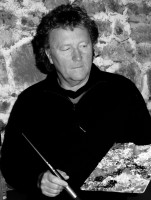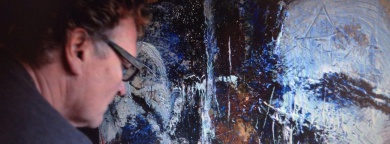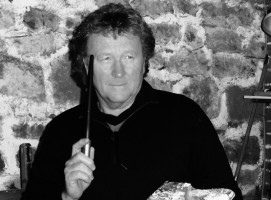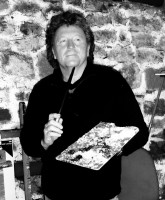About robART
The artist visited Tenby/Wales for the first time in 2008.
- After the death of his wife Uschi in 1999 he found himself unable to focus on the essence of his painting and sculpting work.
- He took a sabbatical from creating and instead taught art at a secondary school in Mülheim. A serious accident in August 2010 forced him to give up this position.
- His great love Helen supported him through the ups and downs of life and motivated him to return to painting and sculpting. Once his health was on the mend, he decided to make a daring u-turn. His love of people, the Welsh and this charming sea landscape were the trigger for closing the circle and returning once more to figurative painting.
- For over 20 years he worked without shape, nearly without subject. He worked with symbols, signs and ancient cultures. He himself cannot say where his path will lead him now. He is going with the flow, following his feelings, following his heart.
Prof. Dr. Siegfried Seeber (close friend)
About the early work
Having finished his studies towards the end of the 70ies and while growing into a life of art, Rob owed his most fruitful inspirations to his study trips.(Italy/Tuscany, France/Provence, Spain, Crete, and Scotland)
Rob’s pictures do not speak about pure reality. They are like colourful reflections of his soul. The Goethe quote to ‘guide your eye toward what is wonderful in this world and feel what is growing inside you´ (from Goethe’s Italian Journey) has become his mantra, the guiding principle of his artistic work.
Rob has the amazing ability to transform the visible, the external, into an internalised picture, and in this respect colour, or rather the light value of the colour, proves to be the decisive medium of his works.
An explosion of forcefulness, a firework of colours, dynamism dynamicism – but judiciously tempered. The figurative is often reduced to colour blocks, creating a union between the atmospheric and the pictorial. Rob makes music with his colours, and in particular his works in his cycle(‘Scottish expressions’) are impressive testament to this. They have sparkle and depth, power and determination, and then again they appear translucent like watercolours.
Dr. Frèdèrik Rothermel (art historian) on the early work of Robert Raschke
Further quotes on Rob’s works:
- „Typical for his paintings is their orchestral colourfulness, submitted down to the minutest micro unit to an enormous power of the colours, which Rob knows to create with the use of brush and palette knife. It is not, however, a pastose mass of paint but a sensitive areal distribution.“
Dr. Tayfun Belgin, art historian and curator
of the Museum Ostwall/Dortmund
- „Even those who are unfamiliar with the artist Rob feel the enormous vitality and power in his artistic expressions, a love of life that is even transmitted to the anonymous viewer. It gives the impression that the picture frames can barely contain the forceful expressiveness.“
Dr. C. Nottermann/Bochum, art historian






